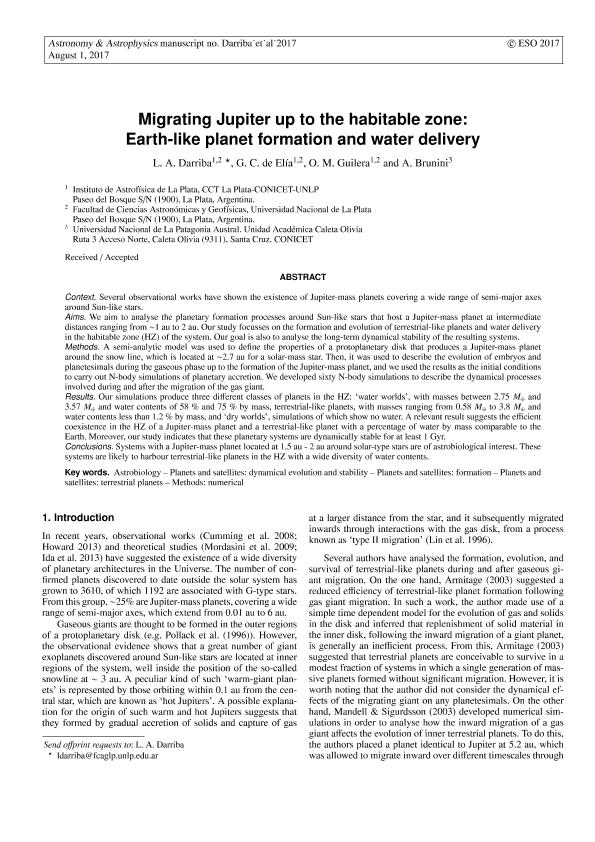Artículo
Migrating Jupiter up to the habitable zone: Earth-like planet formation and water delivery
Fecha de publicación:
08/2017
Editorial:
EDP Sciences
Revista:
Astronomy and Astrophysics
ISSN:
0004-6361
Idioma:
Inglés
Tipo de recurso:
Artículo publicado
Clasificación temática:
Resumen
Context. Several observational works have shown the existence of Jupiter-mass planets covering a wide range of semi-major axes around Sun-like stars. Aims. We aim to analyse the planetary formation processes around Sun-like stars that host a Jupiter-mass planet at intermediate distances ranging from ~1 au to 2 au. Our study focusses on the formation and evolution of terrestrial-like planets and water delivery in the habitable zone (HZ) of the system. Our goal is also to analyse the long-term dynamical stability of the resulting systems. Methods. A semi-analytic model was used to define the properties of a protoplanetary disk that produces a Jupiter-mass planet around the snow line, which is located at ~2.7 au for a solar-mass star. Then, it was used to describe the evolution of embryos and planetesimals during the gaseous phase up to the formation of the Jupiter-mass planet, and we used the results as the initial conditions to carry out N-body simulations of planetary accretion. We developed sixty N-body simulations to describe the dynamical processes involved during and after the migration of the gas giant. Results. Our simulations produce three different classes of planets in the HZ: “water worlds”, with masses between 2.75 M⊕ and 3.57 M⊕ and water contents of 58% and 75% by mass, terrestrial-like planets, with masses ranging from 0.58 M⊕ to 3.8 M⊕ and water contents less than 1.2% by mass, and “dry worlds”, simulations of which show no water. A relevant result suggests the efficient coexistence in the HZ of a Jupiter-mass planet and a terrestrial-like planet with a percentage of water by mass comparable to the Earth. Moreover, our study indicates that these planetary systems are dynamically stable for at least 1 Gyr. Conclusions. Systems with a Jupiter-mass planet located at 1.5−2 au around solar-type stars are of astrobiological interest. These systems are likely to harbour terrestrial-like planets in the HZ with a wide diversity of water contents.
Archivos asociados
Licencia
Identificadores
Colecciones
Articulos(IALP)
Articulos de INST.DE ASTROFISICA LA PLATA
Articulos de INST.DE ASTROFISICA LA PLATA
Citación
Darriba, Luciano Ariel; de Elia, G.; Guilera, Octavio Miguel; Brunini, Adrian; Migrating Jupiter up to the habitable zone: Earth-like planet formation and water delivery; EDP Sciences; Astronomy and Astrophysics; 607; 8-2017; A63
Compartir
Altmétricas




